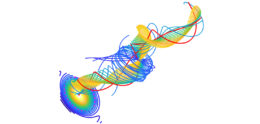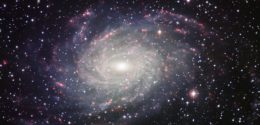It’s been a big year for astronomy. We’ve seen the first image of the Milky Way’s central supermassive black hole, witnessed the launch of new space missions, and finally set eyes upon the first observations from JWST. As 2022 draws to a close, let’s take a look back at some of the amazing science we covered on AAS Nova this year. Here are the top 10 most-read posts of 2022:
10. Featured Image: A Twisted Magnetic Rope
A team led by Qiang Hu used a new quasi-three-dimensional fitting method to analyze spacecraft data of a passing solar storm. This new technique helped the team understand the structure of the storm’s magnetic field. The resulting simulations show three-dimensional winding behavior that was not present in one- or two-dimensional models of the same event, allowing the team to get a better grasp on the intricate plasma physics at play.
Two coronal mass ejections launched from the Sun in November 2000, as seen by the Solar and Heliospheric Observatory. [ESA/NASA/SOHO]
9. Caught in a Solar Storm on the Way to Mars
Two spacecraft at different distances from the Sun happened to lie along the same solar magnetic field line when a powerful solar storm swept through the solar system. A team led by Shuai Fu, Zheyi Ding, and Yongjie Zhang studied the data from the two spacecraft in order to understand how high-energy particles from the Sun travel through the solar system — knowledge that will be critical when planning for crewed space missions traveling beyond Earth’s protective magnetic field.
8. Hydrate or Die-drate: Was Venus Ever Habitable?

Radar image of Venus’s surface today (left) and an imagined version of its past surface (right). [NASA/Jet Propulsion Laboratory-Caltech (left) and NASA (right)]
7. Clues from Quasars in the Early Universe
Quasars — ultra-bright, accreting supermassive black holes in the early universe — are visible up to 13 billion light-years away, providing a way to study young supermassive black holes. But how exactly these black holes become supermassive in less than a billion years is still unknown. A team led by Jinyi Yang approached this question by using infrared spectroscopy to determine the masses and accretion rates of more than three dozen quasars in the first billion years after the Big Bang. The team’s efforts yielded an estimate of the masses of the “seeds” from which the quasars grew, but how the seeds themselves came to be is still a mystery!
6. How Do Milky Way–Like Galaxies Grow?
A team led by Maryam Hasheminia explored the evolution of Milky Way–like spiral galaxies, seeking to understand if similar galaxies’ stars form first in the galactic center, the galactic outskirts, or equally throughout the galaxy. Using observations of suitable galaxies from survey data, the team found that all parts of these galaxies form stars at about the same pace, which is at odds with one of the leading hypotheses for how galaxies grow.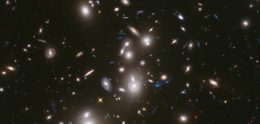
Galaxy cluster Abell 2744 — the focus of the GLASS Early-Release Science program. [NASA, ESA, and J. Lotz, M. Mountain, A. Koekemoer, and the HFF Team (STScI)]
5. Through the Looking GLASS with JWST
At long last, JWST is operational! In the first of several focus issues, researchers introduced the Grism Lens-Amplified Survey from Space (GLASS) Early-Release Science program. This program, led by Tommaso Treu, focuses on the epoch of reionization, during which the first stars in the universe were born. Studying galaxies in the first billion years after the Big Bang is critical to understanding this era, and JWST gives us a window into reionization like we’ve never had before.
4. Winding Up to a Quadrillion Electronvolts of Energy
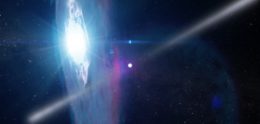
Artist’s impression of a pulsar in a binary system with another star. [NASA’s Goddard Space Flight Center]

The first Event Horizon Telescope image of the Milky Way’s supermassive black hole. [EHT Collaboration; CC BY 4.0]
3. First Image of the Milky Way’s Supermassive Black Hole
In 2019, the planet-wide Event Horizon Telescope delivered the first-ever image of a galaxy’s central supermassive black hole, and this year, we got a similar view of our nearest and dearest supermassive black hole: Sagittarius A*. The images showed a bright ring of emission corresponding to extremely hot gas orbiting close to the black hole, as well as a dark shadow inside the ring that contains the black hole’s event horizon. These images provided another test of Einstein’s general theory of relativity, which passed with flying colors yet again.
2. Solving a Fifty-Year Star-Formation Mystery
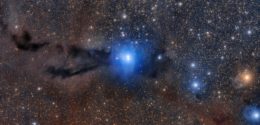
Lupus 3, a star forming region about 600 light-years away. [ESO/R. Colombari; CC BY 4.0]
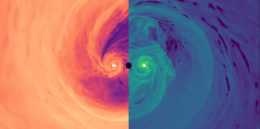
Simulation of matter spiraling around a pair of supermassive black holes. [Adapted from Gutiérrez et al. 2022]
1. Bringing Supermassive Black Hole Mergers to Light
Unsurprisingly, the most-read article of 2022 is about a frequent favorite of astronomers and astronomy enthusiasts alike: black holes! A team led by Eduardo Gutiérrez used simulations to probe the electromagnetic radiation generated when supermassive black holes collide and merge. The team’s results may provide a way to distinguish binary supermassive black holes approaching a merger from single supermassive black holes, hopefully letting us catch them colliding for the first time.
Thank you for joining us for another year of great science — we can’t wait to see the discoveries that 2023 will bring!


